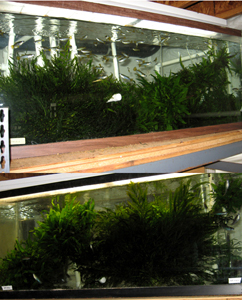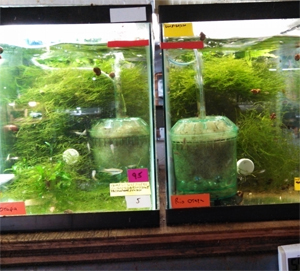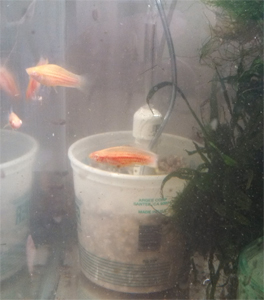|
Select Aquatics of Erie, CO. |
|
|
|
|
 |
Only
in the past 20 years has the nitrogen cycle process that occurs
in our aquariums become well documented.
In the early
1990s, the basic identification of the bacteria involved was
found to be incorrect, further demonstrating that
aquarists have had to depend upon their
own experience to achieve
the best results in their tanks. Published information,
if it could be found, was
of little value.
What many of us know as the “nitrogen cycle”, and what is
referred to in pet-fish texts is encountered when first setting
up an aquarium, as if it were some brief and temporary issue. We
are all familiar with “new tank syndrome”,
where fish in a fresh, dechlorinated aquarium will not thrive
for long, because the nitrifying bacteria have not yet had an
opportunity to populate, and are unable to process the waste
produced. Once the bacterial levels are up, the tank is said
to be “cycled”. Once a tank has been running healthfully
for a few months, it is said to be “seasoned”. At this point
most of us consider a tank to be “mature” and don’t think
of the nitrogen cycle again, other than when cleaning the
tank and filter occasionally.
But many of our aquariums
seem to exist at the whim of some unknown hand. Fish get sick,
other fish seem to die
for no reason. Or worse,
a tank is set up to breed a particular species, and after many
months or even years they
appear to thrive, but do
not breed. Or fish are obtained from someone else that looked
great, but three generations
later your fish never
grow to as large or look as nice as the original fish. All this
comes down to water quality.
And that comes down to
how closely and effectively we are able to maintain our tank.
Effective means simpler,
cleaner, with an
awareness of what the bacteria in a tank can handle, based on
its history, the fish currently in it,
and the organic load
going in and coming out of the aquarium.
This essay will attempt
to address nitrogen cycle issues that arise in fully seasoned
tanks. Problems that arise
can quickly cause
disease, as well as fish that do not thrive or refuse to breed,
and fry that grow out stunted and
undernourished.
Fish are very adaptable,
and hardier commercial varieties found in pet shops can survive
in conditions considered
impossible for the wild
caught species now available in the hobby. Many of these new
species come from genera that
have not been kept in
captivity, requiring a special concern for water quality issues,
and many have done well
when fresh approaches to
fishkeeping are tried. Keeping these new fish, some yet to be
formally identified, then
breed them, has sometimes
proven difficult without considering changes to the way our
aquariums are kept. These
changes have led to tanks
that are easier to maintain, fundamentally cleaner, simpler and
with closer attention paid to
fewer variables. This is
all toward optimum water quality, a minimum amount of effort,
affordability and what is best for
the fish.
Fish have a certain
amount of energy to expend toward growth, breeding, dealing with
stress, fighting off disease, etc.
When a fish has been kept
in a clean, disease free environment, its energy and reserves go
into growth and breeding, as
opposed to a fish living
in a setting where, for example, fending off disease is
commonplace. As a result, the fish in
the cleaner environment
will become larger, breed more frequently, show better color,
etc. than the fish in the less
clean environment. |
 |
|
|
|
|
|
|
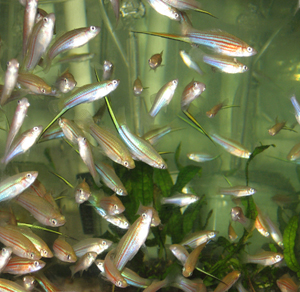 |
|
|
 |
When a tank is
not stressed by excess organic waste,
the plants also reflect the healthy conditions. These
are Bolbitis fern and Java fern in 55 gallon tanks. |
 |
|
When raising the fish that breed for you,
clean conditions allow for fish with good
size and color. These are Xiph. alvarezi |
 |
 |
|
|
 |
New Tank Syndrome and how to avoid
it:
A fresh body of water
when fish are introduced and fed daily will generally “crash”-
in that the organic waste in the tank
will overwhelm the
available bacteria in about 15 days. At that point the water
will become cloudy, and a “bloom” of
bacterial activity will
deplete the oxygen in the aquarium. The fish will be seen
gasping for air at the surface, and soon
the fish will die. This
is avoided in two ways- the first is to introduce seasoned, aged
aquarium water to your newly filled,
dechlorinated tank. This
will “seed” the new tank with the nitrifying bacteria needed to
maintain water quality. Introduce
new fish very slowly, and
allow the tank to cycle by being careful not to overfeed, and
keep the number of fish in the tank
to a minimum for the
first couple weeks.
The second way to
cycle a new tank is to be sure to do 10% water changes about
every other day for the first 2-3 weeks,
while allowing the
nitrifying bacteria to build up. Also keep the number of fish in
the tank to a minimum and be careful
not to overfeed.
_______________________________________________________________
A little background on
Aquarium Cleanliness
Starting, nurturing but
then ignoring the nitrogen cycle often gets aquarists into
trouble, and is a source of confusion
or uncertainty for even
the most advanced hobbyists. Some amount of experience helps to
best recognize when there
is a problem, and then deal
with it effectively before you lose any fish.
For many years aquariums
were kept with a thick layer of gravel over an undergravel
filter that bubbled away, without
concern for the amount of
waste pulled into the gravel that had collected over time,
stressing the fish and constantly
challenging their immune
systems. This resulted in shorter lifespans, and fish that did
not attain their full size or
coloration. Most
aquarists saw an undergravel filter as nearly maintenance free,
entirely unaware of the long term issues
created by keeping
organic waste within the aquarium.
Diseases such as fin rot,
fungal infections, internal and external bacterial infections
can all often be traced back to
poor water quality, which
tie directly to a loss of control over the balance between the
waste going into a tank, and the
nitrifying bacteria’s
ability to process that waste.
These undergravel filters
also set up a see-saw of husbandry, where water quality
fluctuated wildly at each cleaning, and
occasional long periods
of poor water quality was the norm. I have kept aquariums this
way in the past, where a thorough
cleaning a couple times a
year was seen as adequate aquarium care.
In large fishrooms of
over 100 tanks, the aquarist must know accurately how each tank
is filtered, what is kept in it, the
amount of food and other
wastes going into it, the organic load / stocking level of the
tank- which changes daily as the
fish grow- and where the
line is when the bacteria present in any specific tank can no
longer handle the waste produced in
that tank. This considers the type of filtration being used, the water
change schedule, amount of live plants and the manual
cleaning
of tanks being done. When providing for the maximum health of
the fish, you must also be aware that each
species has its own
natural tolerance for ammonia and nitrate- some can handle low
levels, some cannot.
This essay is how to
develop an awareness of the organic load going into a tank, and
its relation to the other factors
working to keep the water
quality at its best for the fish, as well as things that can be
done to improve the bacterial
activity toward a more
consistent, healthier tank.
With this mindset,
particularly in a larger fishroom, this approach works towards
consistency, few variables to consider
when things go wrong, and
the best health, growth, color and breeding from your fish.
_________________________________________________________
Starting with a cycled tank, fish acclimate to their water, and
the bacterial level in the water adjusts to the organic
load being produced in
that tank.
Many of the final “rules”
you will set for yourself will come from your own experience.
How heavily stocked should a
30 gallon tank be with a
box filter, thin layer (1 stone thick) of gravel over half the
tank bottom, weekly 50% water
changes, a few small live
plants, lights, and a temperature of 75 degrees? The old books
used to say “an inch per
gallon”, but three 10
inch Oscars could never go into that 30 gallon aquarium, yet I
could put 30-40 inches of young
plecostomuses in that 30
gallon tank. (Though for only a shorttime- a few weeks- as they
will all be growing, and will
gradually produce more
waste than the bacteria in the tank can handle.
When in doubt, always go
fewer fish, and whenever possible, keep stocking levels lower.
Over time, as you make the best
choices when setting up a
tank, you must get to know the maturity of the tank water, the
type and amount of fish to be
kept, what and how much
they will eat, and the amount of water movement, aeration, and
type of filtration.
Some species are
‘dirtier’ than others in that they give off more waste,
requiring that the bottom of the tank must be
siphoned every few days
for the same number of fish to be kept. Each species handles
water quality, oxygen levels and
crowding differently
based on how they impact the nitrifying bacteria through the
waste they produce.
When breeding and raising
fish in larger numbers, the creation of a bacterial bloom by
overestimating what the tank’s nitrogen
cycle can handle happens
often. In fact, a cloudiness of the water in a tank is often the
first sign that the fish have outgrown
the capacity of the
bacteria in that tank to process the waste being produced.
Immediate action is then taken to save the tank
before the fish expire.
Learning how to prevent this from happening means understanding
how healthy the nitrogen cycle is in
your tank (s).
____________________________________________________________
The organic load
consists of:
The size of the fish in
the aquarium- This will dictate the number and type of fish
kept.
The number of fish in the
aquarium- The fewer the fish, the less waste.
The metabolism of the
fish- High oxygenation fish with active metabolisms produce more
waste and are more sensitive to poor
conditions. Sluggish,
less active fish can tolerate slightly higher density and lower
water quality. Some fish produce a lot of
waste and cannot be kept
at the density of other species.
What the fish are fed-
High protein dry foods, vegetable dry foods, live or frozen
foods all decay and pollute in slightly
different ways. Even when
the majority of the food is eaten, its effect on the water
quality can be substantial, while many
foods do not pollute the
water at all.
How much they are being
fed- The frequency and amount of food fed at each feeding needs
to be considered, keeping an eye
toward getting the
maximum amount of food into the fish as possible while
maintaining water quality. Dry, frozen or live
foods all break down in
the water differently.
Frequency of changing
filters- A wad of dirty filter material is the same sitting in a
filter where the water in the aquarium
is running through it, or
sitting in the middle of the aquarium. Most filter mediums need
to be changed at least monthly.
|
 |
|
|
|
|
|
|
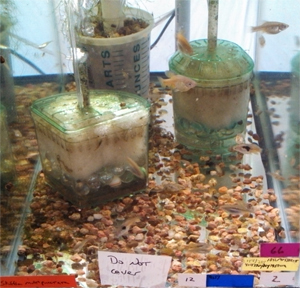 |
|
|
 |
Box filters- the best choice for
simplicity,
low cost, effectiveness and cleanliness. |
 |
|
A perfect
basic tank ready for more fish and plants.
This 29 gallon tank has box filters, a gravel filter
and a single layer of gravel lightly over the tank
bottom. |
 |
 |
|
|
 |
Filtration consists of:
The Size of the Aquarium-
The larger the aquarium, the more forgiving the aquarium is
going to be when an overload of organics
occurs. A 2 inch dead
fish in a 55 gallon aquarium is not going to cause a biological
problem, however, in a 10 gallon,
particularly if the tank
is already to capacity it certainly can.
The type of filtration
you will be using- Using a filter that removes particulate
matter from the aquarium in combination with a
layer
of ¼ inch pea gravel over half the aquarium bottom is
best. Filters that keep the particulate matter in the aquarium
must
be used with manual
removal of particulate matter and possibly heavier water
changes. (undergravel filters, sponge filters)
The amount of nitrifying
bacteria colonizing area – If you are using the gravel method
mentioned above, a wet/dry filter or sponge
filter to supplement
other filtration.
The frequency and amount
of water changes- Most fish do well with their water being
changed a minimum of 20% a week to a
maximum of about 20% a
day. Before using an automatic water changing system, I found
20% twice a week to be a good
amount for the livebearers I was
keeping.
The amount of aeration-
Aeration is very important for the stimulation of bacterial
growth and best for most fish.
The amount of lighting-
Lighting also stimulates bacterial growth and encourages assists
plants etc. to assist filtration.
Whether you are using
live plants- An essential addition to a well filtered, healthy
aquarium.
____________________________________________________________
When determining whether a fish will do well in a particular
aquarium, keep in mind that fish do best in the circumstances
they
have become accustomed.
For example, you keep a fish in fairly clean, consistent
conditions, and then give some of your fish go
to someone else, who may
not maintain the same level of consistent water quality. That
person’s fish may do fine, but your fish
may find the
circumstances too difficult and not thrive, even though the
ammonia and nitrate levels in the tank were within a
normal range.
An awareness of the
organic load in your tank is important with the goal of keeping
it within what the bacteria can handle, as
much as possible. You
need to know the balance between the waste going in, the amount
of nitrifying bacteria, and the amount of
filtration being used.
The debris that can be seen will break down, releasing ammonia
that takes effort from the fish to
accommodate. Also
consider that the main source of waste is that which cannot be
seen, given off by the fish through routine 24/7
respiration, which needs
to be added to the equation.
_______________________________________________________
When a tank is running
well, and the nitrogen cycle is well established, a number
of factors will be present.
- The aquarium water will
be crystal clear.
- Fish will be swimming
at their appropriate levels in the aquarium. (not predominantly
near the surface or at the bottom
if they
normally would not.)
- The fish are out and
confident, and not hiding or cowering in the plants.
- Other creatures-
snails, etc. are also out and about.
- The water does not
become cloudy after a feeding, and the fish are ready to eat
eagerly when the food is presented.
- The fish swim with fins
extended and color is good. The fins are clear and fluid in
motion, eyes are clear and alert.
When
there is a problem, one or more of these factors may be
present.
- The water is at all
cloudy
- The water has a slight
yellow or brown tinge to it, and wood or other substances are
not responsible.
- A foaming may appear at
the water line, and there may be an increase in water tension at
the surface of the aquarium.
- The fish may have their
fins clamped or held restricted, their color may also be darker
or lighter (washed out) than normal.
- The fish’s fins or eyes
may be cloudy, their behavior is slowed or lethargic.
- The fish are breathing
at the surface or cowering near the bottom.
- A cloudy film may form
on the glass, or brown or green algeas may appear.
If nothing is done, fin
rot, fungal infections and sudden deaths will begin to appear
within 1-3 days.
Immediate fixes when
problems are seen-
- Change 50% of the water. Use clean, aged aquarium water from
another disease free tank if at all possible. Otherwise use
the dechlorinated water
used in any other water change.
- Remove the filter
medium and rinse well in clean, aged aquarium water- if
possible, do not discard at this time. You will
need the bacteria to help
get the tank back on its feet, and changing the filter medium
with a 50% water change may be too
jarring for the fish.
Replace the filter medium as you would next time around when the
tank is stable.
- Clean up the bottom of
the tank, looking for any collections of debris. Thoroughly
siphon gravel with a gravel cleaner
if necessary. Wipe the
glass.
- Be sure a light is on
and working over the aquarium. Light stimulates bacterial
growth, plant growth, etc. and improves
the overall health of the
aquarium.
- You may want to add a
medicinal dose of salt (1 tablespoon of salt to 5 gallons of
water) to the tank to assist the
fish to overcome their
clamped fins, etc.
______________________________________________________________________________________________________________
|
 |
|
|
 |
There are 3 types of
filtration commonly found in aquariums. Not all three are needed
in all aquariums, and bacterial filtration
is nearly always present,
but possibly not in adequate amounts. The three types are
mechanical filtration (anything that
mechanically removes
particulate waste by collecting it in some type of medium),
Chemical filtration (such as when charcoal is
used) and biological
filtration. This primarily involves the work of nitrifying
bacteria that occurs in any aquarium after it has
been running for a few
days. The amount of this bacteria can be manipulated, as if
forms on every surface within the aquarium.
The effect of live plants
is also substantial, and is also a form of biological
filtration.
You can run a tank that
is kept “too clean” for some fish. When this occurs, it has come
about when heavy water changes (even
of degassed water- water
that had been allowed to sit for a couple days) and heavy
mechanical filtration created what appeared
to be a clean
environment. However, with the limia nigrofasciata and others,
they did not survive, or did poorly when exposed to
those conditions. An effort is made to routinely
remove any mulm that can easily be seen, and rinsing the gravel
in only clean
aquarium
water- but generally there is no need to remove it.
Rinsing the gravel in tap water would kill the colonized
bacteria.
Most types of modern
aquarium filters will do an adequate job, with the exception of
the undergravel filters that should be avoided.
The filters that best
support a healthy nitrogen cycle are those that remove the
detritus from the aquarium, inhibit collection of
mulm or areas within the
tank where debris can collect, and provide the appropriate
amount of quiet or disruption in the tank that
you are seeking that is
best for the fish. As livebearers, catfish and some cichlids are
bred at this fishroom, aeration generated
filtration is preferred.
This also means that all of the filters run from a central
blower, requiring no additional power for
individual tank filters.
We use the old style 4
inch round box filters with marbles for weight and polyester
floss as the filter medium with a central
blower.
Each tank here is on an
automatic water changing system that changes 15% of the water
daily. A weekly water change is usually
adequate.
________________________________________________________
Essentially, there are 6
factors when setting up a tank to consider so that the bacterial
activity and filtration going on within
the tank is adequate for
the species of fish you are keeping, the number of fish, what
you are feeding, and what you wish to do
with the fish in the
tank- grow them out, breed them, etc.
1. The amount of waste
going into the tank- This includes the number of fish, the size
of the fish, the types and amounts of
of food that are fed, and
other decorations in the tank that may reduce the overall amount
of water and interrupt the flow of
water through the tank.
You do not want a setup that creates areas where debris
collects, or where anaerobic areas can develop-
unless you are willing to
go in and routinely clean those areas. Many aquarium setups
contain these spots where air does not
get to, which can release
hydrogen sulfide- a toxic gas, and the “rotten egg” smell
noticed when cleaning particularly dirty
aquariums. There are
always things to do, so I try to plan for the cleanest setup
such that the required work is quick,
accessible and
infrequent.
Higher protein foods can
be fed more frequently in smaller quantities when the water is
found to cloud up, or it appears the
amount of biological
filtration is not adequate, as it can tend to be responsible for
bacterial bloom problems.
2. The ability of the fish
to handle less than ideal conditions- The fish you are
introducing will always do best in a clean,
cycled aquarium. Keep in
mind, particularly with rare, expensive or possibly wild fish
that a slightly dirty tank- even when
ammonia and nitrate
measurements are outside of toxic levels, the new fish may have
some difficulty before they adjust, and
some fish may simply
expire. Keeping your fish in environments where your awareness
of the tank’s consistent health is where
it should be will nearly
eliminate unexpected surprises.
The potential for the
tank health to deteriorate is always present as time passes-
Tanks are dynamic environments. Fish grow,
they produce young that
demand more from the environment, and a change in one fish’s
health in a community could easily and
quickly affect the health
of every other fish in the tank. The ability of the ongoing
filtration in the tank must be frequently
observed, and changes
made as necessary.
You cannot always predict
how a fish will respond to a certain environment, but a fish
accustomed to a crowded tank or less
than ideal conditions
will always do well in a cleaner environment. A fish kept in
clean conditions, however, may not adapt
if conditions they are
introduced to are not to their liking.
3. The bacterial needs of
the fish- An effort through water changes and quality mechanical
filtration alone to provide
filtration can be too
unnatural for some fish, and a component of biological
filtration must be provided.
The thin layer of gravel
over about half of the bottom of the tank is good, but mulm and
debris must be seen clearly, so that
it can be easily cleaned
up with a siphon, or as I prefer, a turkey baster. A layer of
gravel up to about ½ inch that can be
cleaned regularly can
also be used. However, a layer beyond a few stones deep will
attract and collect organic waste that will
then build up within the
aquarium if the entire bottom is not cleaned regularly (at least
weekly).
4. The type of mechanical
filtration used- Any mechanical filter must remove as much
particulate matter from the aquarium as
possible, and be easy to
access and clean. Allowing filter medium to become filthy within
the filter box is the same as putting
the dirty filter medium
directly into the aquarium. The medium minimizes the surface
area of the debris so that ammonia is not
released as easily into
the aquarium, but a quantity of filter medium collecting dirt as
it should must be changed at least
monthly.
Undergravel filters were
invented 60 years ago as one of the first filters that made
aquarium keeping easy. Unless the gravel
above the filter plate is
cleaned regularly, undergravel type filters are always to be
avoided.
5. The provision of
surface area for nitrifying bacteria without contributing to the
organic load in the tank- By increasing the
amount of surface area
within the tank, you can increase the amount of nitrifying
bacteria and thus the ability of the tank to
assimilate waste.
Generally, gravel will serve that function, but when used in any
depth, it also collects debris and enables
the deterioration of
water quality. By using larger ¼ inch pea gravel in a single
layer across the bottom of an aquarium,
mentioned above, the
biological filtration provided seems to be adequate.
Other standard options
include the addition of a wet/dry filter that runs the water
over plastic bio-balls, cut to enhance
surface area, or creating
with a 1-2 qt. cup and an uplift tube, a gravel filter that
simply pulls the water through the gravel,
and needs to be changed
about every 8 weeks.
6. The water change and
cleaning schedule being done on the tank- Water changes and
the cleaning schedule,
if possible, should not
be your primary defense against the aquarium’s need for
maintenance, or as a substitute for the
type of filtration, air
and setup you really need that is best for the fish. Try to set
up the tank with the filtration,
nitrifying surface area,
tank density and feeding schedule so that disasters are not just
a couple mistakes or a missed
water change away.
The quality of the water
deteriorates in a number of ways, most due to the inevitable
buildup of organic material that happens
in most aquariums. There
are ways during the initial setup to create a tank where you are
always aware of what is going on,
that organic buildup
stays at a minimum, and you can be confident that the fish
experience the best odds of a consistent,
healthy environment.
|
 |
|
|
|
|
|
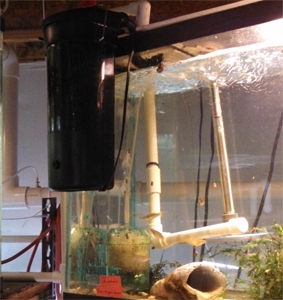 |
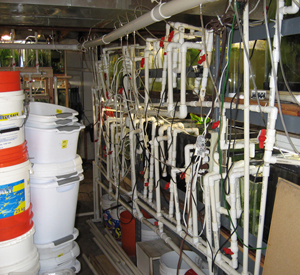 |
|
|
 |
A Homemade Gravel filter made to specifically
boost biological filtration. These work best
with a 1/4" sifted pea gravel to provide maximum
water flow. These need to be cleaned every 2 months.
|
 |
|
A hang-on-the-side Magnum canister
filter for quick resolution of
water cloudiness issues. |
 |
|
A fishroom like this isn't for everyone. This is
a look at the
automatic water change system and
air lines behind two of the 14
racks at Select Aquatics. |
 |
 |
|
|
 |
Special
Filtration circumstances-
Breeding sucker
catfish:
We are breeding
bristlenose plecos here that eat fresh, canned green beans. A 40
gallon tank, containing about 100 plecos
will go through 1/3 – ½
can of green beans a day. Adult breeders in a 55 gallon breeding
tank will eat 1/3 can a day, but
to breed, they require
clear water of high quality. In the grow out pleco tanks the
amount of waste produced by the fish is
clear, and siphoning away
the waste must be done daily. Without extra measures, any of the
pleco tanks would be heavily
clouded by evening after
a morning feeding, and the fish would likely be dead due to
oxygen deprivation by the next morning.
The nitrifying bacteria
in each pleco tank is likely at its maximum density, and the
cycle process is working very well, but
more must be done.
A group of magnum 250
hang-on-the-side canister filters is used with micron filters to
remove the fine particulate matter
given off by the beans as
they eat. The surface area provided by the small fibrous bean
matter easily creates a bacterial
bloom, depleting the
oxygen in the tank if not removed. Catfish require especially
clean water to breed, yet with the plecos
large amounts of plant
material is fed. By using the micron filters, which all clog
within 24 hours, organic waste going into
the tank is brought down
to a level where the natural nitrifying bacteria can keep up, in
combination with the aeration and
filtration of the box
filters also in the aquarium.
Raising fry:
Young livebearer fry must
be raised in separate containers or tanks where they can be
seen, fed and maintained easily. Often,
2 gallon “critter keeper”
containers are used, and they work well for the first few days
when being raised on brine shrimp.
Because brine shrimp
fouls water quickly, light feedings followed by 50% water
changes 1-3x per day are required, with the
presence of an airstone.
With larger numbers of
other types of fry, large amounts of food such as vinegar eels
and microworms are generally fed, both
that will foul the water
as they die, requiring heavy water changes (at least 50%) after
every feeding.
New fry are especially
sensitive to the buildup of ammonia, which causes the water to
become cloudy, and large water changes
(of only clean, seasoned
aquarium water) must be done multiple times a day.
Mechanical filtration
will suck young into the filter, and I have found that 50% water
changes after every feeding for the
first couple weeks pretty
much removes the need for a filter. Airstones are always
provided. Once the young are large enough
for brine shrimp, they
are raised up and divided up into tanks where standard care can
take over.
Another solution used by many fishkeepers is the use of sponge
filters, especially for small fry as they can feed from the
sponge material on
microorganisms that are collected there. These work well, but
are not used here as the debris still stays
in the tank, and the
filters deteriorate relatively quickly. Many aquarists use them
routinely with much success.
The goal is a room of
tanks where disease never visits, all the fish are healthy and
robust and breeding at their maximum.
Everything is organized,
clean and if anything, boring. The best you can hope for is that
others will feel that way about
your room. Like a juggler
with balls in the air, you must know what is really going on
behind the scenes, from the fish’s
point of view.
Greg Sage
selectaquatics.com
selectaquatics@gmail.com
Copyright 2013
|
 |
|
|
|
|
|
|
|
|
|
|
|
|
|
|
|
|
|
|
|
|
